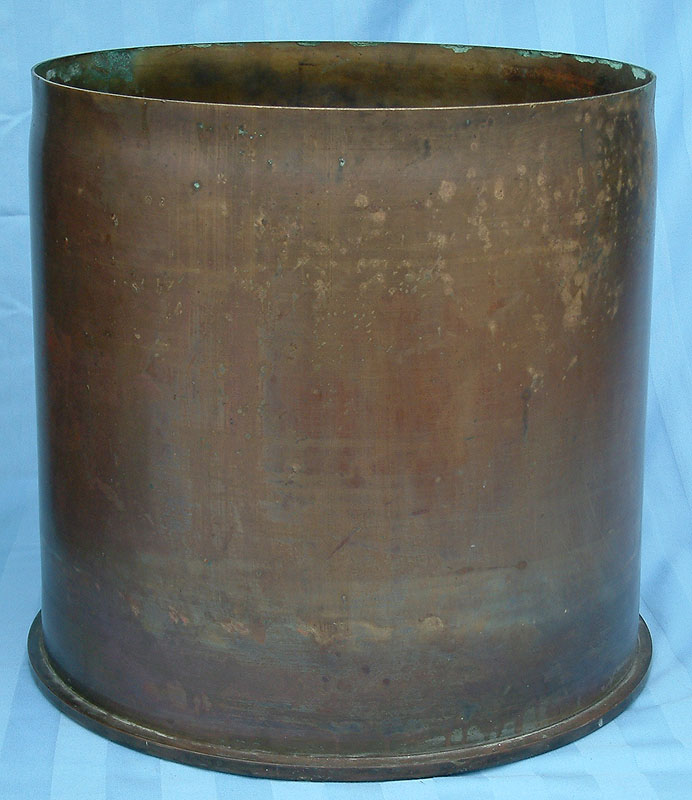| 42cm M-Gerät L/12 Dicke Bertha (Big Bertha) Cartridge Casing | ||||||||||||||||||||||
 | ||||||||||||||||||||||
| 42cm cartridge casing and original transport wicker basket for the legendary Krupp 42cm M-Gerät L/12 Dicke Bertha (Big Bertha). To illustrate the massive size, the casing is photographed with an original Model 1894 2. Garde-Fußartillerie Regt. (Guard Foot Artillery Regiment Nr. 2) Mannschaften (Other Ranks) issued Pickelhaube which would have been worn by the troops firing this weapon. The May 1914 date provides a high probability that this cartridge casing was fired during the destruction of the Belgian forts at Liège, Namur, and others. 42cm M-Gerät L/12 Dicke Bertha Cartridge Casing Data:
|
||||||||||||||||||||||
 | ||||||||||||||||||||||
| A close-up of the head stamping on the base. | ||||||||||||||||||||||
| ||||||||||||||||||||||
 | ||||||||||||||||||||||
| The 465mm (18.30 inches) base of this 42cm cartridge casing shown with an original period model 1894 2. Garde-Fußartillerie -Regt. Mannschaften issued Pickelhaube. The 42cm M-Gerät L/12 Dicke Bertha were manned by gunners of the the Artillerie Prüfungs-Kommission (APK - Artillery Testing Commission) as part of the 2. Garde-Fußartillerie-Regiment. | ||||||||||||||||||||||
| ||||||||||||||||||||||
 | ||||||||||||||||||||||
| Many Füßartillerie cartridge casings were transported in wicker baskets made for the specific cartridge casings; period photos of Füßartillerie emplacements show huge piles of wicker baskets on one side and empty cartridge casings on the other. Inside are large pieces of thick felt to hold the casing in place and the casing fits in like a glove. Very few original 42cm M-Gerät L/12 Dicke Bertha wicker baskets could have survived as they would have fallen apart due to re-use or moisture, been burned as fuel, etc. I am aware of one other survivor in a small county museum in the USA. | ||||||||||||||||||||||
 | ||||||||||||||||||||||
| The lid has a thick wicker insert wired on to hold the casing down snug for transport. | ||||||||||||||||||||||
 | ||||||||||||||||||||||
| On the top and the sides are leather stubs where there were 8 leather straps to hold the top on. They are long gone leaving just the stubs remaining where they were sewn to the basket. Fortunately, both rope carrying handles survive. | ||||||||||||||||||||||
| The 42cm M-Gerät L/12 Dicke Bertha (Big Bertha) | ||||||||||||||||||||||
 | ||||||||||||||||||||||
| Under the ruse of being Kurze Marine-Kanone (KMK = Short Navy Cannon), Krupp under the direction of the German General Staff developed a heavy 42cm siege mortar to be used against permanent fortifications in Belgium and France. Like the 30,5cm Krupp Schwere Küstenmörser (Heavy Coastal Mortar), munitions for 42cm M-Gerät L/12 Dicke Bertha (Big Bertha) were developed by the Army Artillerie Prüfungs-Kommission (APK - Artillery Testing Commission). The M-Gerät was developed to provide the Army with a very large mobile howitzer. The 42cm Gamma-Gerät had already been developed, but at 127 metric tons this howitzer required extensive bedding preparation and required 10 railway cars to be transported.
Only two 42cm M-Gerät L/12 Dicke Bertha were available at the beginning of World War I as part of Kurze Marine-Kanone Bt. 3 (KMK Batterie 3 = Short Navy Cannon Battery 3) under the command of Hauptmann Erdmann. These two 42cm M-Gerät L/12 were used along with the two emplaced 42-cm Gamma-Gerät to destroy the Belgian forts at Liège, Namur, and Antwerp, and the French fort at Maubeuge, as well as other forts in northern France. During the early evening of 12 August 1914, some unknown Kanonier of Kurze Marine-Kanone Bt. 3 pulled the lanyard, the firing pin struck the primer, and 820 kg of armour piercing high explosive was hurtling through the evening air towards the Belgium fort of Liège. 30,5cm Krupp Beta 09 Gerät Data:
There were three Kurze Marine-Kanone Bt. (KMK Batterie = Short Navy Cannon Battery ) known to have deployed in 1914 each with two 42cm howitzers, however, only KMK3 was armed with the 42cm M-Gerät L/12 Dicke Bertha:
| ||||||||||||||||||||||
| ||||||||||||||||||||||
 | ||||||||||||||||||||||
Due to the immense weight of the 42cm M-Gerät Dicke Bertha, to be moved it was broken down into five loads of major components and hauled by Daimler tractors to the staging area where it would be assembled. The photos below (Courtesy Harry van Baal photo archives) show the 42cm M-Gerät being assembled at the Krupp factory, probably during training for the crew.
 The crew behind their 42cm M-Gerät shield and cradle in marching formation. Note the Daimler tractor and the Rad-guertel (wheel pads) affixed to the circumference of the wheels for muddy conditions and to dissipate the ground pressure.. |  Once the hoist was assembled, the component with the recuperators and recoil cylinders was suspended from the hoist so assembly could proceed. The metal platform which provided a stable firing platform for the howitzer has been positioned directly underneath.
|  Next the carriage and cradle component was hoisted up and secured to the recuperators and recoil cylinders .
|  With the barrel and breech now inserted into the cradle, the spade was rolled into place. Note that it's the same two soldiers cranking their guts out on top of the hoist. |  This photo shows the crew attaching the incredibly large spade that absorbed recoil and kept the 42cm M-Gerät on target. |  Now with the 42cm M-Gerät fully assembled, the crew practises load procedure. The 820 kg armour piercing high explosive projectile is rammed home by the crew with a leather plunger on a pole so the copper driving bands of the projectile bite into the barrel rifling, followed by the cartridge casing. Then the breech was closed. Note the large hand-wheel on the back on the trail; the rear of the trail sat in a geared rail on the spade. Although it is good practise to have a 38 ton howitzer pointed in the general direction of the target, this crank would allow the crew to move the move the carriage in azimuth (left/right). | |
 Destruction waiting. A row of 820 kg armour piercing high explosive projectiles wait for their turn in the breech. |  The end of a Bertha. It is generally thought by historians, that most of the eight 42cm M-Gerät Dicke Bertha (or 10 dependant on your source) that were destroyed, was from bursting barrels which resulted in horrendous casualties to the Gunners. | |  |



